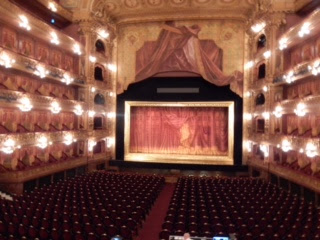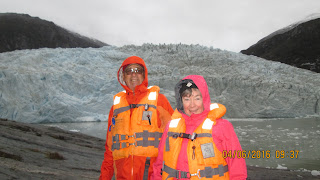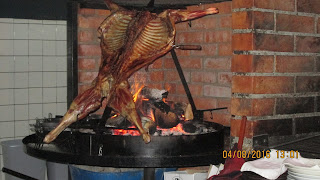Well, Overseas Adventure Travel (OAT) did it again!
They continue to amaze with the quality of their tours and this, our fourth adventure with them, did not disappoint! Our dream for years was to visit Cape Horn by ship. This 14 day tour was the perfect combination of outdoor activities, scenery and excitement.
Many thanks to our fellow travelers, especially Judy, Mike, Ed and Lena, for their magnificent photography which will continue to bring this adventure alive to all who enjoy this blog. Thank you.
We arrived in Buenos Aires at the Amerian Park Hotel. We met our bird expert, and trip leader, Raphael de Biase, and 13 other travelers from Texas, Florida, Tennessee, New Mexico, Minnesota, New Hampshire, Illinois, Washington, Colorado and ourselves from Canada. We even had a father/daughter team, Chuck and Kristi.
First day activities included a tango lesson (click video), a welcome dinner at a family-run restaurant with "secret" tunnels to the harbour.
The next day included a tour of the city. Highlights were the beautiful homes of the Recoletta section, and the Cemetery where many famous people including Eva Peron were entombed.
We were introduced to facturas, a delicious pastry
We visited the pink Presidential Palace behind the "protest wall" as well as the artsy Boca District. They are fond of their futball teams. Peter bought a souvenir "Messi" futball jersey.
Political demonstrations are common, peaceful and accepted. That being said, the traffic jams in Buenos Aires were hard to beat.
Education through the undergraduate university level and most healthcare are free.
The currency denominations are confusing and unfamiliar.

We visited the Colon Theater, one of the world's most famous.
Our day ended with a Home Hosted Dinner with our travel colleagues, Mike & Carol. We learned at least one individual's opinion on local and world politics, religion, and women's roles in South America.
Next morning we flew to Ushuaia which is the name the Yamana, the indigenous people, gave to their settlement, which means "bay that stretches into the sunset". The Yamana are almost extinct.
But what a picturesque harbour! Some handsome sailboats and scenery.
We stopped to meet Gaby and Gustavo for a snack before settling into our Celine Hotel. Gaby shared recipes for her magnificent presentation which included spinach Parmesan bolle, lentil soup, and three milk cake. They have charming daughters and live in a unique home on the hillside of Ushuaia.
That evening we feasted on a dinner of king crab, salad, Cape Horn Beer, and Alamos Savignon Blanc.


Jim and Lynn enjoying a Cape Horn.
Ushuaia began as a penal colony, and there is an interesting Prison museum where we learned that, as in many other countries, inmates were used to build railroads, roads, and were poorly cared for.
 Mike counsels a prisoner while Peter pleads with the warden!
Mike counsels a prisoner while Peter pleads with the warden!Our local guide, Valerie had arranged to have a presentation by a veteran of the 1982 Malvinas War. The other controversial topics include the thousands of children who were taken away from their homes during the military dictatorship of 1976-1983.
Later,Valerie introduced us to Tierra del Fuego National Park where we enjoyed two short hikes and explored the end of the South American Road System, Route 3.
We learned that Argentinians and Chileans love their chocolate shops which are second to none.
We were introduced to mate cups and Yerbe mate, which is a social herb to be enjoyed among friends. You need to carry a mate straw, a thermos of hot water and keep it refreshed often. A great souvenir.
Then, it was the time for us to be boarding our ship MV Via Astralis which was waiting for us at the port.
We were provided with a delicious welcome dinner and drinks. We were introduced to some lovely refreshments: Fuegian Beagle roja Pale Ale, Montes Savignon Blanc, Leyda Valley (Chili) and Astral Calafate ale.
Of course, there were the obligatory safety sessions, and daily instructions about what we would experience the next day, as well as naturalist and historical films of Cape Horn and the Chilean Fjords. Rules were strick: no landings when wind is over 30 knots, seas more than .5 meter or a surge on shore. Life vests were on pegs with room number tags to ensure everyone returned to the ship after an expedition. The staff was exceptional!
Our wonderful waiter, Juan.
MV Via Astralis has been sold to National Geographic trips to the Galapagos. We did send them off well with an auction of the ship's flag and navigational chart of our trip.
During the night Australis rounded the Beagle and Murray Channels to Walaia Bay, part of the Cape Horn National Park, which was once the site of a large native settlement. Walaia Bay was visited by Charles Darwin who landed and described it's very unique vegetation and where the Atlantic and Pacific meet. It was here that we were officially entering Chile as all our passports were collected and stamped by officers who came to our ship.
Overnight, we traveled to Cape Horn. We woke to a position of 55 deg 56 min, 67 deg 19 min, the end of the world, fin de monde, 2400 km from Cape of Good Hope. This is the area of the "roaring 40's (knots). Cape Horn is a 2005 UNESCO Biosphere Reserve and part of Chili Navy. We met the Navy Captain and his wife who with their 2 young daughters have agreed to a one year lighthouse stay. The purpose of the Chili Navy is to maintain sovereignty and navigational lights.
The Captain and his wife live for one year
in the lighthouse with their two daughters.
We have to confess, that we had perfect weather, the entire trip. Our trip leader made us swear not to tell everyone about how beautiful our weather was, because many shore expeditions are cancelled because of inclement weather.
Cape Horn was discovered by the Dutch. Tough sailing in the 1890's. In 1906, 2500 clipper ships joined the Fellowship of Captains of Cape Horn. There is a monument of an albatross to celebrate this auspicious meeting.
I am the albatross who awaits you at the end of the world.
I am the forgotten soul of the dead seamen who sailed across Cape Horn from all the seas of the world.
But, they have not died in the fury of the waves; today they fly on my wings, toward eternity, in the last crevice of the Antarctic winds.
written by Sara Vial, poem in memory of the sea men who lost their lives crossing Cape Horn.
Morning led to the Glacial Alley and Pia Fjord and Glacier. We walked along the metamorphic rocks along the shore and climbed an overlook to view the glacier calving. Later, we visited the Garibaldi Glacier. We enjoyed multiple evening presentations and survival island documentaries of South Georgia Island.
We continued our passage through the Beagle Channel sailing west along the southern edge of Tierra del Fuego. A number of impressive glaciers flow down the Darwin Mountain Range. The Pia Fjord is very narrow for a zodiac visit to the Pia Glacier which extends from the mountaintop to the sea, so we stayed aboard for a panoramic view of this spectacular glacier.
Each day we viewed the screen where our course had been plotted. We encountered some big seas rounding the Magdelena Channels and Breakneck Peninsula on the Pacific side finally arriving at protected Chico Sound. We disembarked in zodiacs with our naturalist to the Alakaluf Fjord to see Pilota (blue) and Nena Glaciers. We went past a beautiful water fall where our naturalist was baptized.
We visited Pia Glacier and Glacier Alley. We went ashore and imagined a drop of water flowing from the Darwin Mountain to the Sea. We experience calving glaciers, which makes a huge thunderous sound and then surge of water as the chunk of ice drops. Glaciers are receding at a record pace today.
After every zodiac expedition, we enjoyed hot chocolate with Johnny Walker Red Label Scotch Whiskey by our outstanding bartenders. Miss Vickie is enjoying!

Peter enjoyed the tour of the engine room with 385 hp engines, etc.
Rafa pointed out flightless steamer ducks and juvenile birds that waited too long to head north, sadly they will not survive. The penguins that we didn't see, had already flown north.
Does it get any better? Next visit was to Chico Sound and Aguila Glacier and the Magelanic forest. We visited the Pilato Glacier by zodiac which is considered "blue" in color.
There was never a time when we were cold. We had been given the advice by Rafa, dress like an onion, in layers. We were warm as toast even with all the icebergs and glaciers around us.
 Magellenic forest.
Magellenic forest.We went on to Punta Arenas where we cleared into Argentina again and were joined by a local guide who showed us the town's highlights before we boarded a bus to Puerto Natalas.
Enroute we stopped at a terrific Argentinian style Barbeque, delicious!

We used this opportunity to shop for headgear. Lena models one suited for her Florida lifestyle and Peter looks handsome in his boino, guacho hat.
We stopped for a break at a place called "Esperaza" where we could buy a good cup of coffee or chocolate. I bought some "submarino"s for our granddaughters which I hope to present them one day to be added to hot milk for hot chocolate.

We stayed at a lovely hotel in Puerto Natalas, also known as the home of a prehistoric giant sloth. Our hotel faced the Senoret Channel which formerly was a big port but because of the preference of air travel to ships, the harbour is very quiet. We enjoyed lovely sunset and sunrises here and they had unique statue art of flying girls and boys and a neat skateboard park.
We traveled next to Torres del Paine National Park, another UNESCO World Biosphere Reserve.
The Patagonian steppe meets the Paine Massif and the topography is breathtaking. Here we met the Andean Condor, the Guanaco, the Patagonian Gray Fox, numerous Eagles and Hawks and the Crested Cara Cara. The Ghea or Nandu (an ostrich like bird) was sighted with sheep.
We never spotted a Puma but we saw the Puma kills. The Condor only approaches dead animals and they are abundant and also beautiful pilots.
We stayed at a most beautiful hotel. We each had lovely rooms overlooking the mountains. We were introduced to "Pisco Sour", Catherine's favourite cocktail.
We enjoyed a lovely hike today to include the Salto Grande Waterfall, and learned all about the many grasses and berries.
We even had an opportunity to ride horses with a gaucho, enjoy phenomenal sunsets and waterfalls.

Glorious desert tables
The Calalfate bush is used for teas, jams, and countless other delicacies. It is said that if you eat the berries, you will return.
Climbed to ancient petroglyphs.
 Can you see the gauchoe on the left? Calafate below.
Can you see the gauchoe on the left? Calafate below.
We learned that, like many other countries, introduced species have had disastrous consequences on their fragile environment. There are measures being introduced to bring foreigners in to extinguish beaver, mink, goat...
Another precaution that is being taken seriously by park service providers, is to restrict campfires. The park is still recovering their great quantities of fragile trees from a uncontrolled campfire years ago. They now require a tour guide to regulate attendance in campsites in these fragile ecosystems.
Our guide, Carolina taught us many things some of which included politics, dog control, cost of living and ownership of land. The lateral morain 25 thousand years ago covered what is natural oil & and gas sources. Argentina is rich in natural resources.
We traveled from Torres del Paine to El Calafate, a long bus ride. We were welcomed by the hotel staff at and then enjoyed walking around the town. The Argentinean gelato parlours are phenomenal.
We visited Perito Moreno Glacier in Los Glaciares National Park, another UNESCO World Heritage Site. There are 50 large glaciers forming around 5,000 ft which is unlike glaciers much higher elevation. The calving here and the boardwalk and balconies to view the glaciers were lovely.
We enjoyed a bit of Fall colours here with the white Birch and Cherry tree forests.

Our visit to Los Glaciaris National Park was spectacular and the Perito Moreno Glacier did not disappoint.


Back in El Calafate, Rafa offered to give us a tour of the Sendero Laguna Nimez and point out the hundreds of bird species.
Our final day we explored the Parana River Delta. This was a get-a-way for the rich and famous years ago and is only accessible by boat. Homes, Schools, Postal Service, Hospitals, Stores, Restaurants, all on stilts, are reached by boat. The Para Delta empties into the Rio De la Plata and on into the Atlantic. Waterways are a bit twisty and high-speed for my tastes but it appears to be enjoyed still by many Argentinians.

A million thanks to our birder and wonderful trip leader, Rafa ! What an adventure!
Salud, pesetas y amor! Y el tiempo para gozarlos
.....toast made famous by our fellow OAT traveler, Ed! Gracias!







 Don & Joy
Don & Joy















































































Great travelogue! Our month and a half in Argentina in 2015 did not permit time to visit Patagonia, but your experience makes a return there very enticing! George and Fern
ReplyDelete